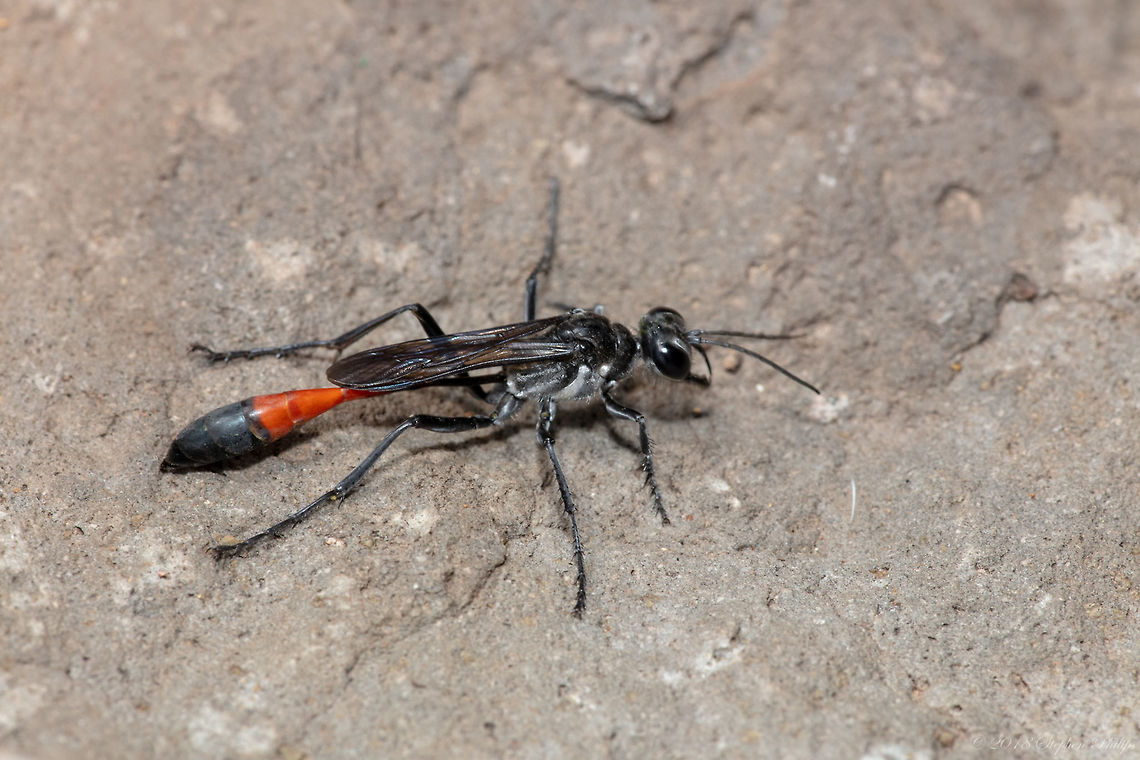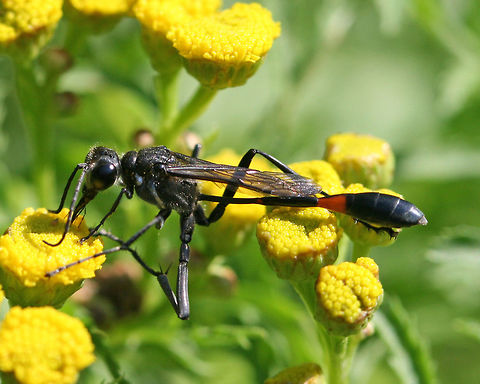 Species introCountry intro
Species introCountry intro
Thread Waisted Wasp
Male. Average length 22.5 mm., range: 15-31 mm.
Color. Black; petiole black or petiole tergite with various degrees of reddening (eastern United States to Rocky Mountains), petiole tergite laterally red, black dorsally (Rocky Mountains to Pacific Coast, petiole sternite sometimes red in Arizona); gastral segment I mostly red, tergite black medially (eastern United States to Rocky Mountains), gastral segments I-II red, tergites with median black spots, tergites III-V laterally and sternites III-V frequently red (Rocky Mountains to Pacific Coast); wings clear or slightly infumate, veins black.
Vestiture. Gena with appressed silver hair along outer orbit (western United States); anterior vertical face of collar frequently with appressed silver hair, collar frequently with a transverse patch of appressed silver hair posteromedially; pronotal side without appressed silver hair; scutal. furrows and peritreme with appressed silver hair; mesopleuron with a band of appressed silver hair along mesopleural suture from base of midcoxa to bottom of hypoepimeral area; inferior metapleural area with a narrower band of silver hair along metapleural sulcus from base of hind coxa to about half the distance to superior metapleural pit; erect head hair black (eastern United States) or pale with occasional black hairs on vertex (western United States), or black and pale mixed in zones of overlap.
Structure. Flagellomere I longer than II (59:41), length of flagellomere I less than least interocular distance (59:68); collar in lateral view as in figure 68, dorsal view, figure 69, collar with numerous strong ridges which are continuous over pronotal side, interspaces shining, impunctate to moderately punctate; mesopleuron moderately to densely macropunctate, interspaces smooth to rugose, often punctatorugose or punctatostriate anteriorly; inferior metapleural area moderately to densely macropunctate, interspaces usually rugose; propodeal side vertically rugosopunctate or punctatostriate; metapleural flange lamellate, nearly as broad to broader than peritreme, outer margin arcuate (figs. 60-61); mesosternal area behind anterior coxae frequently with a pair of angular prominences; right penis valve as in figure 112.
Female. Average length 29 mm., range: 20-35 mm.
Color. As in male except gastral segment I usually completely red, remainder black (eastern United States), or gaster red with black spots on tergites II-IV (California), intermediate color forms in Great Basin region.
Vestiture. Similar to male except gena more broadly silvery (western United States); psammophore black (eastern United States) or pale (Rocky Mountains to Pacific Coast).
Structure. Labrum acuminate; clypeal disk moderately to strongly bulging, densely micropunctate, moderately macropunctate, median tree margin produced, teeth small but well developed; flagellomere I nearly twice length of II (78:44); inner orbits parallel or slightly converging above; pronotum about as in male but not as sharply rising from transverse line (fig. 74); mesosomal details as in male except scutal ridges sometimes obsolescent anteromedially and mesosternal region without angulate prominences.

''Ammophila procera'', the common thread-waisted wasp, is a species of thread-waisted wasp in the family Sphecidae.

comments (4)
PS: I think it is thread-waisted, not three-waisted. Posted 7 years ago